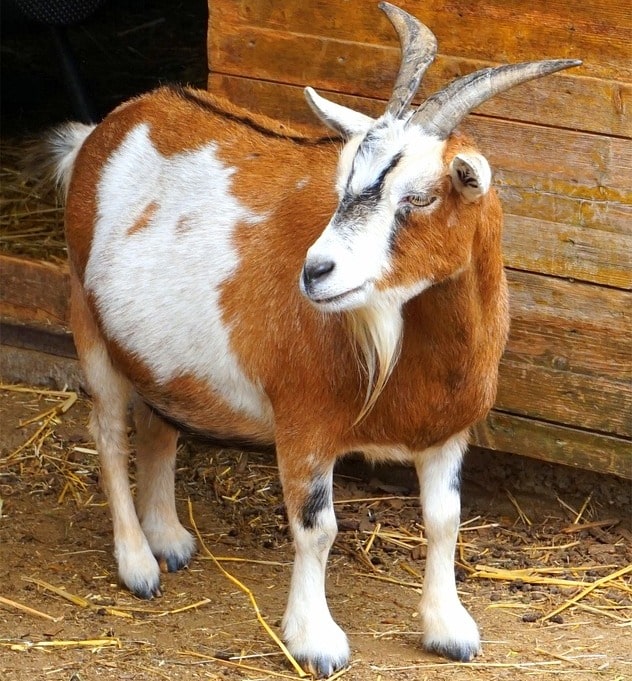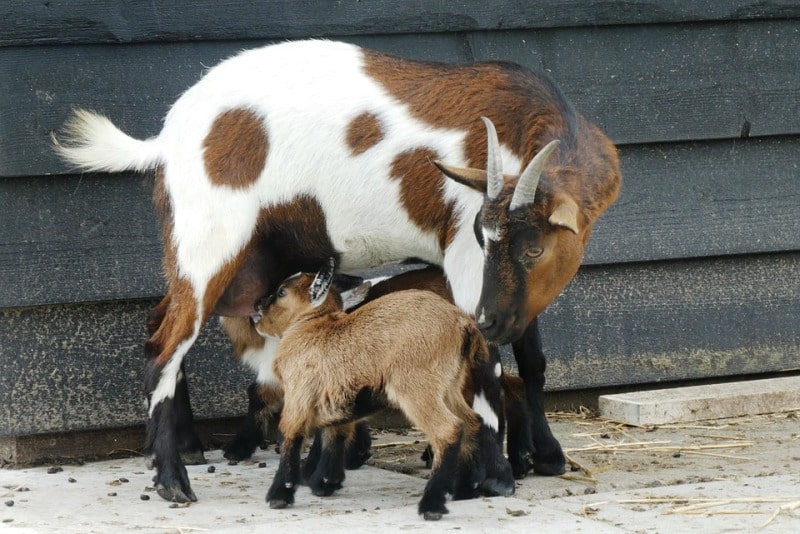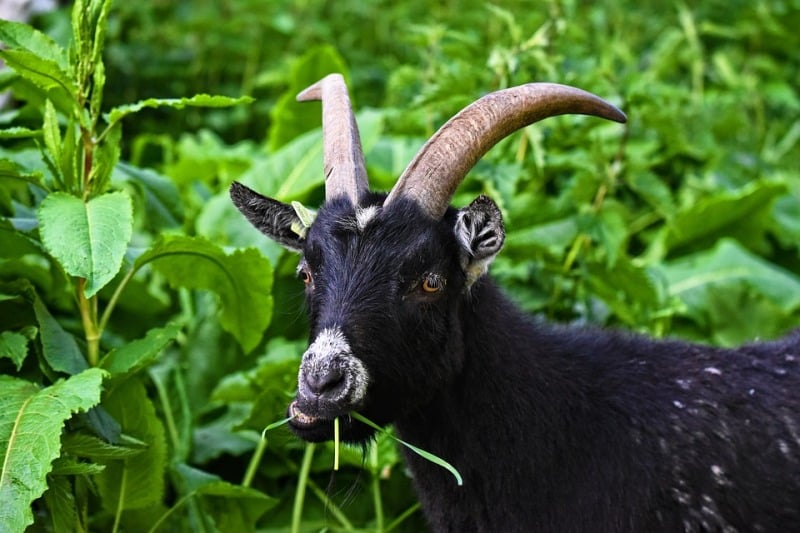Signs of Goat pregnancy, symptoms – A step by step guide:
In any commercial goat breeding, it is very important to identify goat pregnancy signs and symptoms for management of goats. The Goat is a member of the animal family Bovidae and one of the most useful, efficient food-producing animals. The female Goat is called a “doe” or “nanny” and the male Goat is called a “buck” or “billy.”

How to Identify Goat pregnancy signs:
To identify Goat will be pregnant the following signs will be observed in goat. The Goat pregnancy signs will be explained below;
The doe doesn’t come back into heat
This is the main sign to look to identify a signs of goat pregnancy. A doe’s heat cycle will last around 21 days. So every 21 days, give or take a few days, a doe will come back into heat. So, if doe comes into heat and you put her with the buck, and three weeks later she doesn’t come into heat again, then she should be bred.
Appetite goes up, milk production goes down
The appetite of a pregnant doe slowly increases. If she’s being milked, her milk production could gradually decrease as her udder recedes. If a milker does not stop production on her own, stop milking her 2 months before the kids are due, to give her body a rest. Since the gestation period for goats is about 150 days, stop milking no longer than 120 days after the doe was bred.
Increase the size of the Doe
Not every doe will swell up during pregnancy time. However, a lot of people can confirm pregnancy by the size of their doe.
The Doe’s belly tightens
Two weeks after a doe is bred, the belly will tighten, a feature you can detect by firmly pressing your fingers against her belly just in front of udder. A doe’s belly will feel tense and tight.
Shape the Doe will changes
It is common for her right side to stick out further than the left as her kid(s) develop. If a doe is carrying twins or more, she will bulge out just as much on the left side as the right. Some Does, particularly those that have kidded before, don’t swell at the side, but instead develop a saggy belly. Other does, particularly older ones, barely show at all until some six weeks before goat labor begins.
The Doe’s barrel swells
Some of the pregnant does start filling out almost right away. Others don’t show until a few months after being bred, sometimes appearing to balloon overnight. If you compute each doe’s girth that is barrel diameter just behind the front legs at the time of breeding, and then frequently each month, you can detect this gradual increase in size.
Increased appetite and decreased milk production
This is also one of the simple signs of goat pregnancy. You need to stop milking her 2 months before kidding if she does not stop production on her own because her body needs to rest. You will see her interested in eating more frequently.
The Doe snores
All goats sometimes snore when they’re resting, particularly while taking a siesta on a hot summer afternoon. But during goat pregnancy, they snore more and louder than common.
The Doe’s udder swells
One of the easy and simple goat pregnancy sign is that the udder of a goat that has kidded in the past could not begin to fill out until about a month, or sometimes only days before she’s due to kid. If this is the doe’s first pregnancy, her udder must begin to gradually develop about 6 weeks after she settled and become nicely rounded by 12 weeks into gestation.
You may be interested in Kadaknath Egg Production.
Goat gestation period
Usually, Goat gestation period (length of pregnancy) is 150 days. At the end of the gestation period, birth either a single goat is born or twins or triplets. These are the most regular births, although there are less frequent births of numbers higher than this. It is better to breed the female goat once a year. But, some goats can be made to kid twice in 18 months.
Birthing is known as ‘Kidding’ and generally takes place with very few complications at all. After the female goat has given birth, she will eat the placenta which gives her most required nutrients, helps to control blood flow and also reduces the birth scent to predators.
After ‘Kidding’ the female goat will enter a period known as ‘Freshening’. This is where she begins goat milk production. A healthy Doe milk production per day will be six pounds while she is in ‘milk’. The Doe will milk her Kid until it is prepared for weaning at about 10 to 12 weeks old. Neutering early prevents the growth of aggressive behavior and nasty billy goat smells.
Total pregnancy duration in goats typically stay pregnant for about five months, they average 145 days for each pregnancy. Some deliver as early as 142 days, and some goats take as long as 155 days.
Pregnant Goat care
Basically, there are totally three stages of goat pregnancy care to consider; they are
- Breeding,
- Early gestation, and
- Late gestation
At each of these stages, there is a preferred Body Condition Score that must be maintained, specific feeding guidelines and preventative vaccinations or health precautions that are recommended. Some points will be considered while taking care of pregnant goat;
- Keep pregnant goats separated from others
- Provide adequate nutrition, simply digestible and laxative diet
- Do not allow pregnant goats to fight with each other
- Do not allow pregnant goats to mix with recently aborted animals
- Shortly before the doe is due to freshen, clip the hair around the udder part, hindquarters and tail for greater cleanliness.
- If the goat continuous to produce milk, dry her off at least six to eight weeks before expected kidding.
Goat breeding program:

Before breeding, it’s typically suggested that first freshening does be at least 65% of their adult weight, that does Body condition score (BCS) be at 2.5 to 3.0, that they are dewormed (if necessary), and that they receive a BoSe (Selenium + Vitamin E) shot if they’re placed in areas of the country where Selenium deficiency is a problem.
Feeding a grain concentrate first starting 2 weeks prior to breeding and continuing for about two weeks after is suggested to obtain thin does body weight up (you want a BCS of 2.5 – 3.0). However, this wasn’t essential in our case because the Does we planned to breed were getting grain twice a day already (since we were still milking them).
Normal feeding at this period must consist of pasture, hay, and free option goat mineral consist of 16% calcium and 8 % phosphorus (it’s very important to keep the calcium to phosphorus ratio at 2:1 to make sure they’re getting enough calcium). If milking, a grain ration should be fed twice daily.
You may also read Goat Farming in India.
Early gestation (up until last 6 weeks prior to kidding):
The average miniature Goat gestation period is 145 days and the first 3 ½ months are considered the early gestation period. During this time, the embryo(s) grow slowly, and there are generally few observable changes in a doe. BCS should be maintained at 2.5 to 3.0, and it’s important not to stress the doe.
If stressed, a doe at this stage is capable of reabsorbing the embryo and obviously not a desirable outcome. Feeding must consist of medium quality hay, good pasture, and free choice goat mineral and they don’t need grain at this stage if they’re not being milked.
Late gestation (last 6 weeks):
During the last 6 weeks, kid fetal growth increases exponentially, so nutrition must increase to bring the BCS up to 3.5 to 4.0. To do this, feed must consist of pasture, medium to good hay (orchard grass + legume), free choice mineral, and a grain concentrate gradually needs to be added. For the grain concentrate, a 15% protein goat pellet is suggested and at this point, the doe needs to start eating for at least two (herself plus however many kids).
Goat heat signs and heat cycle:
Estrus or heat is the period in which Does are receptive to mating. Signs of heat in goats include tail wagging, mucous discharge, swollen vulva, bleating, mounting or being mounted by other goats, etc.
Estrus, or heat period in a goat, is the doe will stand and allow the buck to breed her. This phase of the reproductive cycle could last between 12 to 36 hours. The stage from one heat cycle to the next is referred to as the estrous cycle. The estrous cycle in goats occurs every 18 to 24 days or 21 days on average. The doe can be bred when she has reached 60 to 70 percent of the average adult weight for her breed (80 pounds for an average Boer doe for example). Does that are bred too early can have problems during kidding (dystocia – kidding difficulty), and their future reproductive performance may be harmed.
Signs that your Goat is in the heat:
- Urinates more frequently
- Milk volume changes
- Buck acts bewildered, or “goofy” almost like it’s drunk
- Loss of appetite
- Her tail gets sticky (red, swollen, wet with discharge)
- Vocalizes more than usual
- Wags her tail (known as “flagging”)
- The does act bucky (mount other does or let other does mount her)
- Personality changes (may act aggressively)
Problems in Goat pregnancy:
We breed our Does individually and thus know approximately when they are scheduled to kid. This is very important for us because it allows us to watch for specific problems during their pregnancy. There are two major types of problems related to pregnancy in goats. They are Pregnancy Toxemia and Abortions. Pregnancy Toxemia is the main problem that we have seen many times. We have never had a problem that we know of where the does aborted though we have talked to a friend that has had abortion problems.
Pregnancy Toxemia
This is a problem in late pregnancy, usually the last month and especially the last two weeks. It is generally related to a doe with multiple kids. During the last 2 months, the kids are adding 70% of their birthing weight. During the final weeks, there are additional nutritional requirements for the kids as continue to increase in size and there is less and less room for the rumen to hold the same quantity of food. The goat’s body will give the kids nutritional needs the priority at the expense of the mother. A goat may not be able to consume enough nutrition and the body will start converting the mother’s carbohydrates stored in her tissues. This leads to the release of ketone bodies into her blood and a sign that her metabolism is faulty.
Some of the symptoms will be a loss of appetite, not wanting to get up or move around, sweet-smelling breath, limping and swelling of feet or walking very tenderly. Ketosis strips can be used to recognize if the doe is ketotic Give doe propylene glycol twice a day. We can give 60cc drench in am and pm. We create a mixture of sodium bicarbonate with water and give 30cc drench am and pm. Help get the doe up and moving around during the day and offering high energy food.
You may be interested to read Smart Farming in India.
Vaccination schedule:
Some of the vaccines make disease resistive power in the body of goats and prevent the diseases to develop. And some vaccines cause the immune system to increase antibodies against them. Antibodies attack the germ or virus of a definite disease and kill them. Thus vaccination in goats plays an important role in keeping your goats healthy, growing, and productive and diseases free.
At four weeks prior to kidding, it’s recommended that the does be vaccinated with CD&T, given BoSe (in areas with Selenium deficiency), and some breeders vaccinate or treat to prevent abortions. The CD&T vaccination ensures that the kids will have tetanus immunity (through the colostrums they receive after birth) and the BoSe prevents white muscle disease in kids. Vaccinating or treating to prevent Doe’s abortions is dependent on the condition causing the abortions and needs to be coordinated with a veterinarian.
Adult Goat vaccination schedule
Vaccinate pregnantly does or female goats during their last month of pregnancy to assure good immunization for the kids. Have bucks, vaccinated the same time as the does. Yearlings, or does that are not bred, and wethers (castrated males) should be vaccinated yearly on the same date they received their previous vaccination.
Pregnant Does
First 28 to 45 days of pregnancy does prefer a Chlamydia vaccine. Vaccinate does during last month of pregnancy for Clostridium perfringens type C and D and C.tetani, and also referred to as a CD & T vaccine shot.
Guidelines to give vaccination to goats:
Follow these guidelines when giving a vaccination to goats:
- To minimize the chance of an adverse reaction, vaccinate goats when they are in good health.
- Do not utilize expired or cloudy vaccines.
- Use a 20-gauge, one inch or 3/4-inch needle on an adult, or a half inch needle on a kid.
- Follow the manufacturer’s instructions for dosage.
- Use a clean and new, sterile needle and syringe on each goat.
- Do not mix vaccines.
- For the best result, do not delay booster shots.
- Keep a record of vaccinations given.
Feeding program for pregnant goats:

A feeding program for pregnant goats includes:
Early pregnancy (first 3 months)
Feed does maintain body condition or to improve their body condition if they are thin. You can meet their nutritional requirements with quality hay or pasture, or some added grain for thin does. Unless they’re lactating, does don’t want grain in early pregnancy. Do not overfeed while in early pregnancy. Overfeeding can lead to some complications such as hypocalcemia and ketosis.
Throughout pregnancy
Monitor and compensate for pregnant does improve water consumption. Pregnant goats can drink up to 4 gallons a day. Monitor body condition and regulate feed and water accordingly.
Late pregnancy (last two months)
As part of goat pregnancy signs, Does’ nutritional requirements increase greatly through this time because the unborn kids are growing rapidly. Start grain gradually (just a handful a day) until does are eating up to a half-pound of grain a day (depending on the goat size and breed) or half to two-thirds of their common milking ration by the time the kid, in addition to hay. Gradually replace their hay with alfalfa so they get the accurate balance of calcium and phosphorus. Continue to monitor body condition and adjust feed accordingly; does carrying multiple kids want even more calories and nutrients.
That’s all folks about symptoms and signs of goat pregnancy.
Read: Growing Kale, Planting, Care and Harvesting.